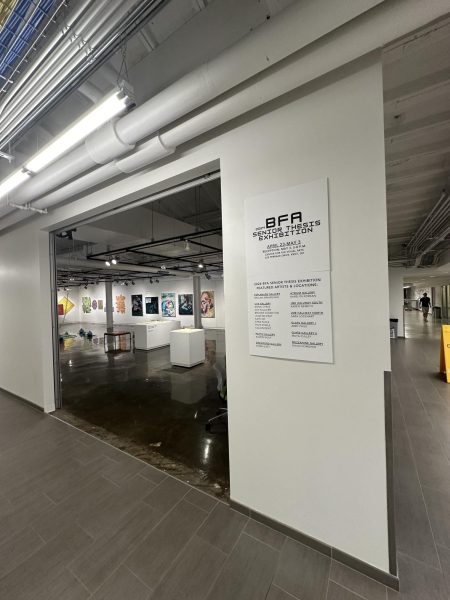Nursing students receive real-world experience through disaster simulation
April 12, 2016
Students in the Community Health Nursing course participated in a disaster simulation at 8:30 a.m. Tuesday. Kent State collaborated on the event with the Portage County Health Department and the Emergency Management Agency.
“What this (event) is showing nursing students is there is another side of their profession,” said Becky Lehman, the public information officer for the Portage County Health Department. “This is giving them another look at how they can help and give back to their community. In a real-life situation, we would call upon our medical volunteers to help us assist. We could not do this large-scale (situation) without help.”
Pamela Rafferty-Semon, a lecturer for the College of Nursing and a coordinator for the event, said the College of Nursing will do a simulation at the end of every semester. The simulation focuses on a different hypothetical scenario every time.
“The scenario is that a bomb fell on the Student Center, and they found it was laced with a white powder. It is anthrax,” Rafferty-Semon said. “We’re trying to get a lot of people here in a short amount of time. They could be anxious, they could be hurt from the blast or they could be a family member who was around when the blast went off.”
According to the Ohio Health Department, anthrax is an illness that forms from a bacteria called bacillus anthracis. When the bacteria is exposed, it forms spores that are highly resistant to both physical and chemical agents. The simulation focused on inhalation anthrax, which can be presented as respiratory distress with fever and shock. The mortality rate is 80 to 100 percent.
Before the simulation, the nursing students received information on anthrax and the simulation from Rafferty-Semon. Marianne Kitakis, a member of the nursing division for the Portage County Health Department, also spoke to the students about “how we (nurses) can run a drill in a critical emergency.”
However, some nursing students still did not know what to expect.
“We do simulation labs, but not like this,” Katina Faunda, a senior nursing student, said. “You do not know how serious to take it because your peers are involved in it, and you want to joke around sometimes and laugh, but at the same time, you think, ‘My professor is over me, so I have to be serious.’”
During the simulation, there were five stages. Each stage served a different purpose to the simulation, and the nursing students had to spend a half an hour at each station before quickly rotating. The second and last stages focused on paperwork and speaking with patients, and the third and fourth stages focused on what antibiotics to administer to patients.
At the first station, nursing students were given the roles of victims who had been affected by the anthrax. Students were given a piece of paper that told them what their symptoms were, and whether they were a victim or a bystander. Some were even given props, such as crutches and wheelchairs.
Emily Petit, a senior nursing student was there at the simulated explosion, in her role, was visibly shaken. Petit pretended that she first went home from the shock, but then came back to the scene.
“They sent me straight to the doctors because they could see I had a lot of anxiety,” Petit said.
Although every nursing student participating in the simulation played the role of a victim or bystander, volunteers from the Kent community could play the victims, too. Rafferty-Semon said there is always a need for volunteers.
Julie McCaffery, a senior economics student, read about the volunteer opportunity on the Kent State homepage. She decided to volunteer to participate in the simulation.
“I thought it would be great to see a simulation in a real-world disaster situation and be able to see firsthand what the Portage County system does,” McCaffery said. “I am also an apocalyptic buff. I watch a lot of those movies, and I thought it would be cool.”
Students found certain parts of the simulation to be challenging.
“I would say that the first station where they are trying to find out where to send you (victims) next to see if you have been exposed to anthrax (is the most chaotic),” said Ali Pace, a senior nursing student.
Overall, the nursing students found the simulation helpful.
“You can see the importance of teamwork and working together in a scenario like this in real life because it would be really scary,” Pace said. “I think the simulations like this where we get to practice what we are learning about is helpful in our nursing practice.”
Cassidy Pittman, a senior nursing student, said, “It (the simulation) makes what we learn from a book reality. If we ever want to be in a real situation, it will not be the first time.”
After the simulation, the nursing students and their supervisors evaluated their performances.
“I think it went very well,” Kitakis said. “We were trying to introduce the students to the preparedness portion of what the health department does. There’s always things we improve on. We always look at how it went and how we can do it better and make it more streamlined.”
A similar simulation will take place on Thursday at 8 a.m at the Student Recreation and Wellness Center. Students are encouraged to volunteer and be a part of this fun and educational exercise.
Lauryn Rosinski is a health reporter for The Kent Stater. Contact her at [email protected].






















